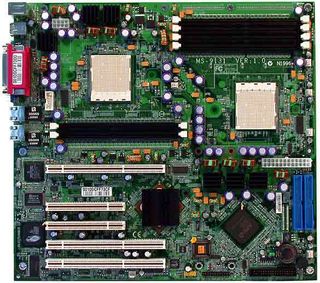Duel of the Titans: Opteron vs. Xeon
Conclusion, Continued
Regarding the architecture of the Opteron, AMD has integrated the 64 bit extensions into the existing x86 concept smoothly and efficiently. There are few problems in moving to 64 bit under Linux: the operating system has been 64 bit capable for years (starting from kernel 2.0), and only the kernel has to be replaced anew. In Windows 64 bit is another issue altogether. Still, the incorrigible complainers and pedants won't have to worry: apart from a very few exceptions, 32 bit software will continue to run without any problems.
The Hammer architecture, compared to the previous Athlon, does not offer any huge changes in the core design or the command processing. More emphasis was placed on optimizing it with regard to higher clock frequencies. A 12-level pipeline is supposed to work together with SOI technology to create potential for higher frequencies. The model numbering system for server CPUs is worthy of some criticism: the number 244 (the current top model with 1.8 GHz) is truly confusing. And it won't be of any extra help to see the notes in AMD's documents that 44 is faster than 42 but slower than 46. How about interpreting the "44" as 4400+ in the rating?
In the end, this number has to have some sort of concrete relationship to the actual performance of the CPU. A maximum frequency of 2.4 GHz (model 52) should be available with SledgeHammer in the mid-term. In any case, numbering has to be made more transparent, so that the clientele can have a point of comparison. However, it must be said, the server customer is not interested in performance by itself, but in stability, software development, support, and availability.
Next stop, the desktop version of Hammer, the Athlon 64 with Dual DDR333 or even DDR400 interface. And then Prescott.
| Opteron 240 | 1.4 GHz | $283 |
| Opteron 242 | 1.6 GHz | $690 |
| Opteron 244 | 1.8 GHz | $794 |

The first dual motherboard for the AMD Opteron with AMD chipset.
Mirko Dolle from www.linux-magazine.com is our consulting editor at the THG lab.
Stay on the Cutting Edge
Join the experts who read Tom's Hardware for the inside track on enthusiast PC tech news — and have for over 25 years. We'll send breaking news and in-depth reviews of CPUs, GPUs, AI, maker hardware and more straight to your inbox.
Current page: Conclusion, Continued
Prev Page Multitasking: 3D Studio Max 5.1 And Main Concept 1.3Most Popular

